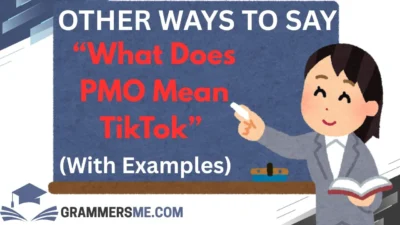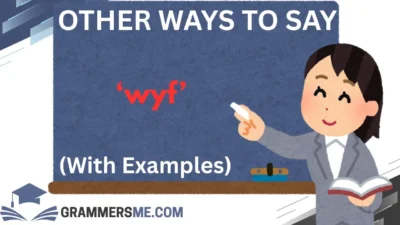In a world that thrives on connection, even a simple “TTYL” (Talk To You Later) can carry more weight than we realize. Whether you’re chatting with a friend, signing off from a heartfelt conversation, or leaving a sweet note at the end of a message, finding the right way to say goodbye — and mean it — makes all the difference.
The alternatives you choose can reflect warmth, care, and a sense of being present. So, if you’re ready to ditch the default and communicate with more heart, this list of thoughtful “TTYL” alternatives is for you.
What Does “TTYL” Mean?
TTYL stands for “Talk To You Later.” It’s a casual, often friendly way to wrap up a conversation, with the implication that the speaker will reconnect with the other person sometime soon. It’s quick, efficient, and widely used in texting and online messaging.
Is It Professional/Polite to Say “TTYL”?
TTYL is polite enough for casual conversations, but it’s not typically seen as professional. In workplace communication — especially with clients or leadership — it’s better to opt for phrases like “I’ll follow up with you later” or “Let’s touch base soon.” For friendly chats or texting with loved ones, TTYL is totally fine.
1. Catch you later
Meaning: A casual and friendly way to say goodbye for now.
Explanation: This is one of the most natural substitutes for “TTYL” and suggests you’ll reconnect soon.
Example: “Alright, I’ve got to run. Catch you later!”
Best Use: Perfect for friends, coworkers, or casual chats.
Not Use: Avoid in very formal or professional emails.
Tone: Easygoing, warm, familiar.
2. Talk soon
Meaning: Implies a brief pause in conversation, not a final goodbye.
Explanation: Offers a softer, more intentional version of “TTYL.”
Example: “Thanks for the update. Talk soon!”
Best Use: Suitable for work and personal contexts.
Not Use: Not ideal for final conversations where no follow-up is expected.
Tone: Warm, open, thoughtful.
3. Chat later
Meaning: Suggests a future conversation in an informal tone.
Explanation: Short and simple — just like “TTYL,” but more modern-sounding.
Example: “Dinner’s ready, I’ll chat later!”
Best Use: Great for text convos or group chats.
Not Use: Avoid in email sign-offs or with unfamiliar people.
Tone: Light, friendly.
4. Text you later
Meaning: Indicates intention to message again later.
Explanation: More specific than “TTYL” and better for text-based interactions.
Example: “Heading into class now. Text you later!”
Best Use: With people who expect text messages.
Not Use: When other platforms or calls are the norm.
Tone: Personal, casual.
5. I’ll message you later
Meaning: Indicates you’ll reach out later through a message.
Explanation: Friendly and adaptable across platforms.
Example: “Can’t chat right now, but I’ll message you later, okay?”
Best Use: When you genuinely plan to follow up.
Not Use: As an excuse to end a convo you don’t plan to continue.
Tone: Sincere, conversational.
6. Catch up soon
Meaning: Suggests more than a brief chat — a deeper future conversation.
Explanation: Implies intentional reconnection.
Example: “Busy day ahead, but let’s catch up soon!”
Best Use: Ideal for friends, old colleagues, or loved ones.
Not Use: When a short chat is all that’s expected.
Tone: Warm, thoughtful.
7. I’ll be in touch
Meaning: Indicates that you’ll reach out again.
Explanation: Professional and polite, yet warm.
Example: “Thanks for the chat — I’ll be in touch soon!”
Best Use: Business emails or professional follow-ups.
Not Use: When you don’t plan to follow through.
Tone: Polished, dependable.
8. Ping you later
Meaning: Lighthearted way of saying you’ll reach out.
Explanation: “Ping” implies a quick, informal contact.
Example: “Heading out now — I’ll ping you later!”
Best Use: In tech, startups, or with coworkers.
Not Use: With people unfamiliar with digital lingo.
Tone: Playful, informal.
9. TTYS (Talk to you soon)
Meaning: A slightly warmer variation of TTYL.
Explanation: Conveys the same message with a hint of eagerness.
Example: “This was fun. TTYS!”
Best Use: Friendly chats and texts.
Not Use: In professional communication.
Tone: Sweet, informal.
10. Talk later, friend
Meaning: Adds a personal touch to your goodbye.
Explanation: A great way to show care and familiarity.
Example: “Heading to the gym. Talk later, friend!”
Best Use: Close friends or casual conversations.
Not Use: With acquaintances or in business settings.
Tone: Personal, affectionate.
11. Until next time
Meaning: A poetic way to end a conversation.
Explanation: Implies you’ll meet or chat again soon.
Example: “Loved this convo. Until next time!”
Best Use: For warm closings or when parting after a meaningful chat.
Not Use: When no future contact is planned.
Tone: Warm, elegant.
12. Later on
Meaning: Slangy version of “see you later.”
Explanation: Super chill and informal.
Example: “Alright, I’m out. Later on!”
Best Use: Texts or casual convos.
Not Use: In formal messages or meetings.
Tone: Chill, relaxed.
13. I’ll hit you up later
Meaning: Urban slang for reaching out.
Explanation: More common among younger audiences.
Example: “Gotta run, but I’ll hit you up later!”
Best Use: Casual chats, DMs.
Not Use: Professional or cross-generational communication.
Tone: Street-smart, laid-back.
14. Let’s reconnect soon
Meaning: Suggests a meaningful check-in later.
Explanation: Shows intentional care.
Example: “Loved catching up. Let’s reconnect soon.”
Best Use: With friends or colleagues you value.
Not Use: When you don’t actually plan to reconnect.
Tone: Sincere, warm.
15. I’ll talk to you in a bit
Meaning: Implies a short wait before continuing.
Explanation: Less final than “TTYL.”
Example: “BRB — I’ll talk to you in a bit!”
Best Use: Conversations where you’ll return shortly.
Not Use: When there’s no actual plan to talk again soon.
Tone: Comforting, casual.
16. Check in with you later
Meaning: Suggests you’ll follow up or see how they’re doing.
Explanation: Thoughtful and shows emotional investment.
Example: “Hope everything goes well — I’ll check in with you later.”
Best Use: When you genuinely care about their wellbeing.
Not Use: As a throwaway phrase without follow-up.
Tone: Caring, intentional.
17. I’ll follow up with you
Meaning: You’ll reconnect about something specific.
Explanation: Professional and task-oriented.
Example: “Thanks for the update — I’ll follow up with you next week.”
Best Use: Workplace communication, project updates.
Not Use: Casual chats.
Tone: Responsible, professional.
18. I’ll circle back later
Meaning: You’ll return to the conversation or topic.
Explanation: Common in business or task-driven environments.
Example: “Noted. I’ll circle back later with more info.”
Best Use: Work-related convos, project updates.
Not Use: When being warm and personal is the goal.
Tone: Efficient, professional.
19. Until then
Meaning: “Goodbye for now” with a gentle note of anticipation.
Explanation: Warm and reflective, it creates a sense of pause rather than end.
Example: “I’ll be thinking of you — until then!”
Best Use: For emotional closings, especially with loved ones.
Not Use: Formal emails or quick sign-offs.
Tone: Thoughtful, affectionate.
20. Let’s talk later
Meaning: Intention to reconnect without setting a time.
Explanation: Easy and open-ended.
Example: “Got a meeting — let’s talk later!”
Best Use: Casual, everyday convos.
Not Use: With someone expecting a more specific time.
Tone: Friendly, relaxed.
21. I’ll reach out later
Meaning: You’ll initiate another convo or message.
Explanation: Clear and actionable.
Example: “I have to head out, but I’ll reach out later!”
Best Use: Texts or DMs where you want to stay in touch.
Not Use: When you don’t plan to follow through.
Tone: Polite, approachable.
22. Drop you a line soon
Meaning: An old-school way to say you’ll message again.
Explanation: Nostalgic, but still sweet.
Example: “Busy this week, but I’ll drop you a line soon.”
Best Use: When you want to sound heartfelt or old-fashioned.
Not Use: With younger audiences who may find it unfamiliar.
Tone: Warm, charming.
23. I’ll touch base later
Meaning: You’ll reconnect, often about something discussed.
Explanation: Common in business or collaborative settings.
Example: “Let’s move forward — I’ll touch base later to check in.”
Best Use: Workplace, networking, or collaborations.
Not Use: Personal chats with emotional depth.
Tone: Direct, courteous.
24. See you later
Meaning: Casual and visual, even in texts.
Explanation: It suggests a future meeting, even digitally.
Example: “Off to bed. See you later!”
Best Use: Close friends or everyday chats.
Not Use: Where you’re not actually “seeing” the person.
Tone: Friendly, casual.
25. I’ll check back with you
Meaning: Suggests you’ll reinitiate contact for updates or just to connect.
Explanation: Good when something is pending.
Example: “Sounds good — I’ll check back with you in a couple of days.”
Best Use: When there’s follow-up expected.
Not Use: To abruptly end conversations.
Tone: Respectful, proactive.
26. Let me know when you’re free — we’ll chat then
Meaning: You’re giving them control over when to reconnect.
Explanation: Shows respect and flexibility.
Example: “I know you’re busy — let me know when you’re free, and we’ll chat then.”
Best Use: With busy friends or colleagues.
Not Use: If you need an immediate reply.
Tone: Kind, respectful.
27. I’ll shoot you a message later
Meaning: Informal promise to send a follow-up.
Explanation: Feels personal and low-pressure.
Example: “Can’t respond right now — I’ll shoot you a message later.”
Best Use: With people who appreciate relaxed communication.
Not Use: In professional or unfamiliar relationships.
Tone: Chill, genuine.
28. Let’s keep in touch
Meaning: A warm promise to stay connected.
Explanation: Slightly more long-term than “TTYL.”
Example: “Really loved this chat — let’s keep in touch!”
Best Use: After a meaningful or new connection.
Not Use: If you’re unsure about staying in contact.
Tone: Sincere, friendly.
29. More soon
Meaning: You plan to continue soon, like a part two.
Explanation: Short, sweet, and slightly mysterious.
Example: “Gotta go for now. More soon!”
Best Use: When a deeper conversation is in progress.
Not Use: For abrupt endings.
Tone: Thoughtful, intriguing.
30. Until we talk again
Meaning: A warm, almost poetic goodbye.
Explanation: This phrase is full of care and anticipation.
Example: “This has been lovely. Until we talk again.”
Best Use: With close friends, loved ones, or meaningful convos.
Not Use: With people you don’t know well.
Tone: Deep, gentle, heartfelt.
Conclusion
Words matter — even the little ones at the end of a text or call. Choosing something other than “TTYL” gives you a chance to infuse a bit more warmth, intention, or even professionalism into your everyday goodbyes. Whether you’re talking to a best friend, a new connection, or a colleague, there’s a perfect phrase to match your tone and make them feel seen, even in parting.
As someone who’s worked in communication across both professional settings and personal storytelling, I’ve seen firsthand how small changes in language can shift the entire mood of a message. Pick what resonates with your style — and let your sign-offs be just as thoughtful as the conversation that came before.
FAQs
1. Is “TTYL” outdated now?
Not necessarily! It’s still used, especially in texting, but some people prefer more modern or personal alternatives.
2. Can I use “TTYL” in a professional email?
It’s better to use alternatives like “I’ll follow up with you” or “Let’s connect later” in professional settings.
3. What’s the warmest alternative to TTYL?
“Until we talk again” or “Let’s reconnect soon” feel the most heartfelt and intentional.
4. Are any of these options flirty?
Yes! Phrases like “More soon” or “Talk later, friend” can definitely carry a flirty undertone depending on context.
5. How do I choose the right alternative?
Think about the person, the relationship, and the tone of the conversation. Choose one that matches your intent and feels natural to say.




